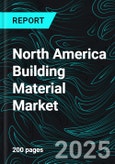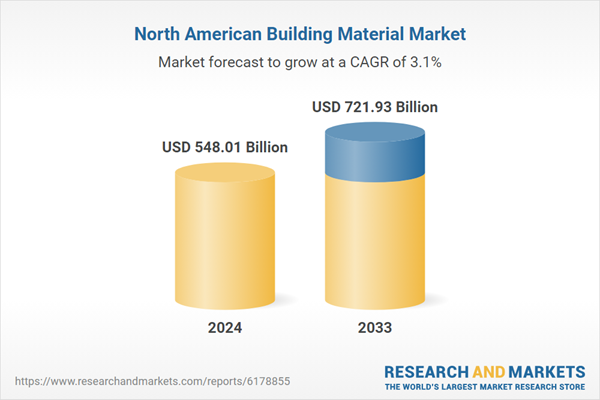North America Building Material Industry Overview
Substances used in the construction of residential, commercial, and industrial buildings are known as building materials. They offer durability, aesthetic appeal, and structural integrity. Cement, concrete, steel, wood, glass, bricks, and composites are common building materials. Energy performance and sustainability are improved by advanced materials like smart glasses, engineered wood, and energy-efficient insulation. A number of variables, including cost, design preferences, environmental conditions, and structural requirements, influence the choice of building materials. Building material innovations also prioritize safety, longevity, and carbon footprint reduction. All things considered, building materials are the foundation of the construction sector and help to shape the built environment.Growing construction activity in the infrastructure, commercial, and residential sectors is driving the North American building materials market. The need for new homes, workplaces, and industrial areas is driven by urbanization and population increase. Government expenditures on public facilities, roads, and bridges are examples of infrastructure improvements that boost market expansion. The use of recyclable, energy-efficient, and environmentally friendly building materials is encouraged by sustainability trends. Prefabricated and modular construction are examples of technological advancements that increase productivity and save prices. Demand is also increased by an increase in remodeling and renovation projects in developed countries. The North American building materials sector is still growing thanks to a robust economic recovery and trends in real estate development.
Growth Drivers for the North America Building Material Market
Increasing Construction Activities
One of the main factors propelling the North American building materials market is the rise in construction activity. Building projects are being fueled by the region's rapid urbanization, population growth, and increasing demand for residential, commercial, and industrial spaces. Building materials like cement, steel, bricks, glass, and insulation are needed in large quantities for new residential developments, office buildings, shopping malls, and industrial facilities. Furthermore, the demand for premium materials that guarantee structural durability and safety is being driven by the expansion of the commercial real estate industry, especially in urban areas. Prefabrication and modular building methods are two examples of technological developments in construction that are speeding up project schedules and using more materials. Long-term market growth is supported by the region's persistently high demand for dependable and effective building materials as it invests in major development projects and grows its urban footprint.Sustainability Trends
The market for construction materials in North America is increasingly being shaped by sustainability concerns. Eco-friendly building techniques that lessen their negative effects on the environment and increase energy efficiency are becoming more and more important to governments, developers, and consumers. The use of low-carbon, renewable, and recyclable materials is promoted by the implementation of green construction standards, such as LEED and WELL certifications. Energy-efficient insulation, low-emission paints, engineered wood, and modular composites are just a few of the innovative sustainable building materials that are becoming increasingly popular. Additionally, the need for materials that improve building performance while reducing carbon footprint is driven by growing awareness of climate change and resource conservation. Businesses that offer long-lasting and ecologically friendly materials profit from rising government subsidies and consumer demand for sustainable products. All things considered, the sustainability movement is encouraging the sector to adopt more environmentally friendly procedures, opening up long-term prospects for North American suppliers, manufacturers, and construction companies.Infrastructure Investments
Investments in infrastructure are essential to the expansion of the building materials market in North America. There is a steady need for building materials due to government programs and financing for major infrastructure projects like roads, bridges, airports, railroads, and public buildings. For these projects to be safe, long-lasting, and compliant with regulations, premium and long-lasting materials including concrete, steel, asphalt, and composites are needed. The need for building materials is further increased by rising public spending on transportation network expansion and urban infrastructure modernization. Material consumption is also influenced by the private sector's involvement in the creation of commercial infrastructure, such as smart cities and industrial centers. The building materials industry benefits from a consistent and long-term demand pipeline as governments prioritize infrastructure development to support urbanization and economic growth, highlighting its importance in North America's construction ecosystem.Challenges in the North America Building Material Market
High Raw Material Costss
One of the biggest obstacles facing the North American construction materials business is the high cost of raw materials. Because of changes in global demand, trade regulations, and supply chain limitations, the prices of basic materials like steel, cement, lumber, and glass are extremely unstable. The profitability of manufacturers, contractors, and developers is impacted by rising material costs, which also directly increase production and project expenses. Price increases might induce cost-cutting measures or delay construction projects, especially for small and mid-sized suppliers. Production expenses are further increased by inflationary pressures and rising energy prices. To control costs, businesses frequently have to use long-term contracts, strategic sourcing, or substitute materials. The expansion of the market as a whole may be impacted by persistently high costs, which may also limit new construction and remodeling activity.Environmental Regulations
In North America, environmental restrictions present major obstacles to the building materials sector. To lessen the sector's environmental impact, governments enforce stringent regulations on emissions, waste management, energy efficiency, and sustainable sourcing. Manufacturers must invest in recycling programs, cleaner production technologies, and certification procedures in order to comply with regulations, which may raise operating expenses. Supply chains are made more complex by regulatory control that also covers construction methods, material management, and disposal. Fines, project delays, or harm to one's reputation may arise from noncompliance. Even though these rules encourage sustainability, smaller enterprises with fewer resources may find them especially difficult to comply with. Continuous monitoring, training, and capital investment are necessary to adjust to ever-changing policies, which puts further strain on market competitiveness and profitability.United States Building Material Market
The United States building materials market is one of the largest in North America, driven by robust construction activities across residential, commercial, and infrastructure sectors. Rapid urbanization, population growth, and rising demand for housing, offices, and industrial spaces fuel consumption of materials like cement, steel, timber, glass, and composites. Government investment in infrastructure projects, such as highways, bridges, and public facilities, further stimulates demand. Sustainability trends are encouraging the adoption of eco-friendly and energy-efficient materials, while technological innovations like prefabricated and modular construction enhance efficiency. Challenges include fluctuating raw material prices, environmental regulations, and skilled labor shortages. Despite these constraints, the market continues to expand, supported by economic growth, real estate development, and increasing renovation activities.Canada Building Material Market
Canada’s building materials market is experiencing steady growth, supported by government infrastructure spending, urban development, and a growing construction industry. Residential housing, commercial complexes, and public infrastructure projects drive demand for materials such as cement, steel, wood, and engineered products. Sustainability is a key trend, with developers increasingly adopting green building standards and energy-efficient solutions. Technological advancements, including modular construction and smart materials, are improving efficiency and reducing costs. The market also benefits from strong collaborations between private companies and research institutions. Challenges include high raw material costs, regulatory compliance, and limited skilled labor availability. Overall, Canada’s market is expanding gradually, with long-term opportunities in eco-friendly, durable, and innovative building materials.Recent Developments in North America Building Material Market
- In May 2025, S2 Technologies launched its second-generation magnesium cement building materials. The Gen 2 platform offers a durable, noncombustible alternative to conventional materials such as gypsum and oriented strand board, which are prone to moisture damage, mold, and limited fire resistance. The new product addresses performance gaps and mitigates supply chain challenges associated with imported magnesium oxide (MgO) products, offering a reliable and high-performance solution for construction applications.
- In June 2023, Saint-Gobain announced the completion of a definitive agreement to acquire Building Products Corp., a privately held Canadian manufacturer specializing in roofing shingles and wood fiber insulation panels, for an undisclosed cash amount. The transaction, expected to close in 2021, values Building Products Corp. at approximately C$1.325 million (around USD 979.37 million). This acquisition strengthens Saint-Gobain’s position in Canada, allowing it to expand its sustainable and innovative product offerings to better serve local customers.
North America Building Material Market Segments:
Type
- Aggregates
- Cement
- Bricks
- Metals
- Others
Application
- Residential
- Commercial
- Industrial
Country
- United States
- Canada
All companies have been covered from 5 viewpoints:
- Company Overview
- Key Persons
- Recent Development & Strategies
- SWOT Analysis
- Sales Analysis
Key Players Analysis
- CEMEX
- Boral Limited
- Lafarge Holcim
- Dyckerhoff AG
- Buzzi Unicem SpA
- CSR Limited
- CRH Plc
- Aditya Birla Group
- Ambuja Cements
- USG Corporation
Table of Contents
Companies Mentioned
- CEMEX
- Boral Limited
- Lafarge Holcim
- Dyckerhoff AG
- Buzzi Unicem SpA
- CSR Limited
- CRH Plc
- Aditya Birla Group
- Ambuja Cements
- USG Corporation
Methodology
In this report, for analyzing the future trends for the studied market during the forecast period, the publisher has incorporated rigorous statistical and econometric methods, further scrutinized by secondary, primary sources and by in-house experts, supported through their extensive data intelligence repository. The market is studied holistically from both demand and supply-side perspectives. This is carried out to analyze both end-user and producer behavior patterns, in the review period, which affects price, demand and consumption trends. As the study demands to analyze the long-term nature of the market, the identification of factors influencing the market is based on the fundamentality of the study market.
Through secondary and primary researches, which largely include interviews with industry participants, reliable statistics, and regional intelligence, are identified and are transformed to quantitative data through data extraction, and further applied for inferential purposes. The publisher's in-house industry experts play an instrumental role in designing analytic tools and models, tailored to the requirements of a particular industry segment. These analytical tools and models sanitize the data & statistics and enhance the accuracy of their recommendations and advice.
Primary Research
The primary purpose of this phase is to extract qualitative information regarding the market from the key industry leaders. The primary research efforts include reaching out to participants through mail, tele-conversations, referrals, professional networks, and face-to-face interactions. The publisher also established professional corporate relations with various companies that allow us greater flexibility for reaching out to industry participants and commentators for interviews and discussions, fulfilling the following functions:
- Validates and improves the data quality and strengthens research proceeds
- Further develop the analyst team’s market understanding and expertise
- Supplies authentic information about market size, share, growth, and forecast
The researcher's primary research interview and discussion panels are typically composed of the most experienced industry members. These participants include, however, are not limited to:
- Chief executives and VPs of leading corporations specific to the industry
- Product and sales managers or country heads; channel partners and top level distributors; banking, investment, and valuation experts
- Key opinion leaders (KOLs)
Secondary Research
The publisher refers to a broad array of industry sources for their secondary research, which typically includes, however, is not limited to:
- Company SEC filings, annual reports, company websites, broker & financial reports, and investor presentations for competitive scenario and shape of the industry
- Patent and regulatory databases for understanding of technical & legal developments
- Scientific and technical writings for product information and related preemptions
- Regional government and statistical databases for macro analysis
- Authentic new articles, webcasts, and other related releases for market evaluation
- Internal and external proprietary databases, key market indicators, and relevant press releases for market estimates and forecasts

LOADING...
Table Information
| Report Attribute | Details |
|---|---|
| No. of Pages | 200 |
| Published | September 2025 |
| Forecast Period | 2024 - 2033 |
| Estimated Market Value ( USD | $ 548.01 Billion |
| Forecasted Market Value ( USD | $ 721.93 Billion |
| Compound Annual Growth Rate | 3.1% |
| Regions Covered | North America |
| No. of Companies Mentioned | 10 |









